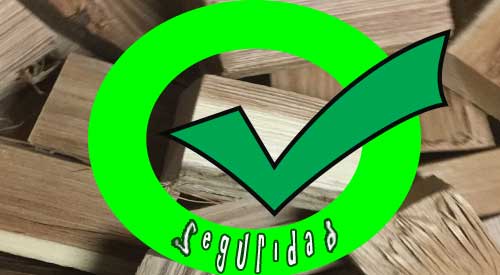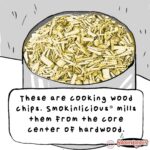 |
| Our food scale demonstrates guidance on adding wood for food smoking. |
Let’s break this down by equipment and method of smoking so you have a good place to start in answering the above questions.
Get A Food Scale- Step #1 in Adding Wood for Food Smoking
As
a reminder, wood should not be sold or referenced by weight so I always
recommend you keep a food scale handy to weigh pieces of wood or
handfuls of wood chips until you get comfortable with eyeballing your
needs. After practicing on your specific equipment, you’ll develop a
sense of how much will produce a smoke infusion level you and your food
guests like.
To make easier understanding of the amount of wood needed, I will be referencing by ounces in my breakdown lists.
Adding Wood for Food Smoking in The Traditional Smoker
If
you adhere to the basic rule of low temperature cooking on a smoker,
then you’ll likely be cooking between 225° and 250°F. You will also
likely be using lump charcoal
or traditional charcoal known as briquets, for the fuel or heat. That
is the material that keeps the smoker at a steady temperature.
Regardless
of whether you use the snake method, minion method, or simply dump the
charcoal in the smoker’s charcoal area, adding wood for food smoking
will be needed in some form to provide the actual smoked flavor to the
foods. Why? Because it is what gives foods that smoky flavor and distinct texture and appearance.
For the smoker, here is a guide on the quantity based on food being smoked and for using wood chunks. Note, you can smoke different foods at the same time with small adjustments to these amounts.
Guide
| Fruits/Vegetables | Turkey/Chicken | Ribs | Pork Shoulder/Brisket |
| 2-4 ounces | 4-6 ounces | 8 ounces | 10 ounces with additional needed during cooking |
For
placement of the Double Filet chunks, these can go directly on the hot
coals with some banked to the side to catch as the hot coals spread.
Adding Wood for Food Smoking Using the Charcoal Grill
Essentially,
you will be doing the same steps as above for the traditional smoker.
The main difference between these two units is that smokers are for hot
smoking and generally don’t do well when used for grilling. In fact, I
would highly recommend you never try grilling on a smoker. Charcoal
grills, on the other hand, can do both but you will have to make some airflow adjustments
with the unit’s venting to ensure that you can maintain a low
temperature consistently for smoking. You also may find adding a heat
insulator like bricks or stones works well to attract and use radiant
heat.
Here is the guide on quantity based on food being smoked as well as type of wood product. Remember, a wood chip product will combust faster so you will need more chips on hand when hot smoking.
| Wood | Fruits/Vegetables | Turkey/Chicken | Ribs | Pork Shoulder/Brisket |
| Chips | 2 ounces | 6 ounces | 10-12 ounces | 16 ounces |
| Chunks | 2-4 ounces | 4-6 ounces | 8 ounces | 10-12 ounces |
For placement of the wood chunks,
these always go on top of the charcoal. You should have a piece on the
hot coals and then stage some on unlit coals that will ignite during the
cooking process and keep the flavor going.
Adding Wood for Food Smoking Using the LP/Gas Grill I
think the key misnomer is that LP/Gas Grills can only use smoker chips
if you want to attempt to do wood-fired cooking. That has certainly
changed with the advent of dual fuel or multi-purpose grills on the
market today, as well as the development and design of diffusers over
the gas burners for traditional grills. The heat covers on burners are
the perfect place for wood chunks.
Even
if you don’t want to add chunks directly to a component of the grill,
you can use a standard chip smoker box and simply put chunks in the box
versus chips. Usually these boxes will hold 3-4 small chunks of Double
filet. The box also aids in capturing ash.
Here are the options for placement:
- smoker wood chips in a foil pouch placed over a hot burner or directly on a heat bar/diffuser
- smoking wood chips in a smoker box placed on the grill grate with the heat under it
- smoking wood chunks in a smoker box (these will be small pieces about 2×2-inches) place on a grill grate with the heat under it
- smoker wood chunks directly on a heat bar/diffuser (3-4 pieces) with the heat on medium
Here
is a guide on the quantity based on food being smoked as well as type
of product. Remember, a wood chip product will combust faster so you
will need more of it on hand than wood chunks when hot smoking.
| Type | Fruits/Vegetables | Turkey/Chicken | Ribs | Pork Shoulder/Brisket |
| Chips | 2 ounces | 6 ounces | 8 ounces with replenishment needed as they reduce to ash | 8 ounces with replenishment needed multiple times |
| Chunks | 2-4 ounces | 4-6 ounces | 8 ounces – may need to add an 1-2 pieces | 8 ounces with replenishment needed at least once |
Also, keep in mind that if you’ve purchased a “green” wood or air-dried wood,
it likely holds more moisture than a kiln dried products. This will
change the weight. Pieces of wood that fall into the “green” category,
even if they are the same size, will weigh differently. Work with wood
long enough and you’ll develop a feel for what is just about at the
perfect weight for smoker or direct-fired cooking.
Adding Wood for Food Smoking to Dual Fuel or Hybrid Grills
With
technologies advancing in the grill world you now have so many more
options for using charcoal and wood in the convenience of a gas fired
grill. For those looking to have that level of ease but the flavors of
charcoal and wood at your fingertips, those equipment manufacturers are
to be considered. Just get ready to make a substantial investment as
these models do not come cheap.
We hope this article provided you
with new information about adding wood for food smoking. Leave a
comment and remember to follow us on social media for additional tips,
techniques, recipes, and great photos. As always, your suggestions on
other article topics are always welcome. Hope you can use our blog.
Our Readers Are Asking…
How often should I add wood to my smoker?
There
is no fixed rule. The quantity/quality with the right kind of wood,
wood that is “moisture managed” produces the best smoke possible. With a
consistent cooking fire or heat source, the familiar phrase “less is
more” is your guide on adding wood for food smoking, especially when
using chips or chunks. When smoke diminishes, add a bit more.











